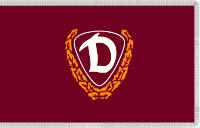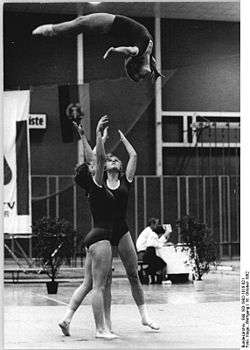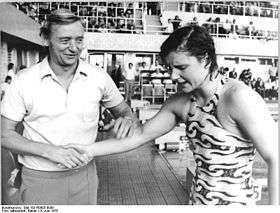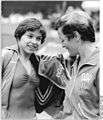SV Dynamo
 | |
| Founded | 27 March 1953; dissolved: 23 November 1989 |
|---|---|
| League | Olympics, World cup, European Championship Nat. League |
| Based in |
East Berlin, |
| Arena | Palast der Republik, Dynamo-Sportforum, Altenberg bobsleigh, luge, and skeleton track, Dynamo Sports Hotel |
| Stadium | Dynamo Stadium (Dresden), Friedrich Ludwig Jahn Sportpark, Heinz Steyer Stadion and others |
| Colors |
wine-red white/ wine-red silver |
| Owner(s) | Ministry of Interior of the GDR: Volkspolizei, Zollverwaltung, Ministry for State Security, Feuerwehr |
| President | Erich Mielke |
| Championships | 2.187 nat.; approx. 182 European cup medals approx. 324 World cup medals; approx. 215 Olympic medals[1] |
The Sportvereinigung Dynamo (German: ![]() Sportvereinigung Dynamo ) (Dynamo Sports Association) was the sport organization of the security agencies (Volkspolizei, Ministry for State Security and customs) of former East Germany. The sports club was founded on 27 March 1953 and was headquartered in Hohenschönhausen in East Berlin. From the date of its inception until 23 November 1989 the president of the SV Dynamo was Erich Mielke, who was also the Minister of State Security. Dynamo was created in accordance with the multi-sports club model developed in the Soviet Union and adopted throughout Eastern Europe. From the beginning it had an overtly political as well as sporting agenda and its many successes were always portrayed as a triumph of the GDR state. During the German reunification in 1989 the SV Dynamo was liquidated. At its height the association had a membership of over 280,000 active members.[2] Athletes of the association enjoyed considerable success both in national and international competitions, winning for example more than 200 olympic medals. After the German reunification the systematic doping of Dynamo athletes from 1971 until 1989 was revealed in German media reports. The systematic doping of athletes was done under the supervision of the Staatssicherheit and with full backing of the government.[3]
Sportvereinigung Dynamo ) (Dynamo Sports Association) was the sport organization of the security agencies (Volkspolizei, Ministry for State Security and customs) of former East Germany. The sports club was founded on 27 March 1953 and was headquartered in Hohenschönhausen in East Berlin. From the date of its inception until 23 November 1989 the president of the SV Dynamo was Erich Mielke, who was also the Minister of State Security. Dynamo was created in accordance with the multi-sports club model developed in the Soviet Union and adopted throughout Eastern Europe. From the beginning it had an overtly political as well as sporting agenda and its many successes were always portrayed as a triumph of the GDR state. During the German reunification in 1989 the SV Dynamo was liquidated. At its height the association had a membership of over 280,000 active members.[2] Athletes of the association enjoyed considerable success both in national and international competitions, winning for example more than 200 olympic medals. After the German reunification the systematic doping of Dynamo athletes from 1971 until 1989 was revealed in German media reports. The systematic doping of athletes was done under the supervision of the Staatssicherheit and with full backing of the government.[3]
Organization

The SV Dynamo was divided into fifteen regional units, corresponding to the fifteen districts of the German Democratic Republic. Within each regional unit individual sports clubs existed, with each sport club specializing in different disciplines. 290 sections were included SG Dynamo Dresden (football), SC Dynamo Hoppegarten (judo, shooting sports, parachuting), the SC Dynamo Klingenthal (Nordic skiing), SG Dynamo Luckenwalde (wrestling), SG Dynamo Potsdam (rowing and canoe sprint), SG Dynamo Weißwasser (ice hockey) and the SG Dynamo Zinnwald in Altenberg (biathlon, bobsleigh, luge, skeleton). The most famous sports club of the SV Dynamo was probably the SC Dynamo Berlin offering most Olympic disciplines. The sports system was not designed for transfers, but on schedule. The athletes had to be viewed in their own country.
Administrators and coaches from Dynamo Berlin were often sent to support their development. The district organizations always wore the initials SV Dynamo ... . The districts been the same districts of the state. [4] For small children, there was even a Dynamo-Kindergarten. Henceforth the larger children trained every day before and after classes. For the training, there existed a basic plan. If the children themselves are not good at school, they were excluded from the training. The emphasis has been respected that the athletes had to pursue themselves the sporting ideology, because otherwise no success would have been guaranteed. Each year, the best Dynamo-athlete were voted. Few could win 50,- M when they themselves were those who chose the sportswoman/ sportsman of the year. Dynamo employed a planning cycle that set out the club's objectives for the upcoming four-year period.
Politics
This sports club was anti-fascistic and communistic. The grounders of thus were former prisoners in concentration camps and leaders in the battle against National socialists and Social Democrats at the Weimar Republic. The Dynamo-Youth commemorated about it at the Soviet War Memorial (Treptower Park), Sachsenhausen concentration camp. The names of murdered/death communists was given as honorary titles for Dynamo-Clubs, which must fought for it... . For example: SG Dynamo "Feliks E. Dzierzynski" Dresden or SG Dynamo "Dr. Richard Sorge" Erfurt. There were also many hymns and odes of Dynamo, which would written. Gerhard Kube, Helmut Baierl and Kurt Barthel formed many poems, which playing the sports club a role.
SV Dynamo districts

The districts been the same districts of the state with: Sportvereinigung Dynamo District - Organisation Rostock, Sportvereinigung Dynamo District - Organisation Neubrandenburg, Sportvereinigung Dynamo District - Organisation Schwerin, Sportvereinigung Dynamo District - Organisation Magdeburg, Sportvereinigung Dynamo District - Organisation Potsdam, Sportvereinigung Dynamo District - Organisation Frankfurt Oder, Sportvereinigung Dynamo District - Organisation East Berlin, Sportvereinigung Dynamo District - Organisation Cottbus, Sportvereinigung Dynamo District - Organisation Halle, Sportvereinigung Dynamo District - Organisation Leipzig, Sportvereinigung Dynamo District - Organisation Erfurt, Sportvereinigung Dynamo District - Organisation Gera, Sportvereinigung Dynamo District - Organisation Suhl, Sportvereinigung Dynamo District - Organisation Dresden and Sportvereinigung Dynamo District - Organisation Karl-Marx-Stadt. Every district has owned a wine-red silk banner with these writing. The measure is 2.8 × 1.5 m, with, of course, a logo of the SV.
Members
Key to East German sporting success was a pyramid system with schoolchildren being assessed for athletic potential and the best (typically the top 2.5%) in each school-year being offered specialised coaching. A small fraction of those would go on to become the top adult athletes of the next generation. This model was initially derided in the West as a "sausage machine" but it has since been adopted in modified form by Australia, France, Spain and others with thousands of children being educated at specialised (often residential) sports schools rather than going through the normal high school system. Overall, 3,7 million athletes were in the GDR at the German Sports federation (DTSB) registered in many other successful clubs in 1989.
| Year | Adults | Children | Total |
|---|---|---|---|
| 1953 | 23162 | none | 23162 |
| 1955 | 55991 | 10874 | 66856 |
| 1958 | 90160 | 18846 | 109006 |
| 1961 | 105530 | 42822 | 148352 |
| 1966 | 118651 | 54691 | 173306 |
| 1970 | 131752 | 74266 | 206018 |
| 1972 | 139013 | 85295 | 224308 |
| 1974 | 144356 | 93071 | 237427 |
| 1975 | 146127 | 96666 | 242793 |
| 1976 | 148054 | 99337 | 247391 |
| 1983 | 170.000 | 110.000 | 280.000 |
Trainers
Most coaches were also teachers or had other specific occupations. They were all in principle to took members fears before starting competitions. Also said that never was like everything bad could happen if .... Problems are always packed at its source in order to eradicate this. At the same time, they were also the guardian of morality.
| Year | Level 1 | Level 2 | Level 3/4 | Total |
|---|---|---|---|---|
| 1964 | none | none | none | 9989 |
| 1965 | none | none | none | 9673 |
| 1966 | 6785 | 2466 | 1362 | 10613 |
| 1967 | 6717 | 2476 | 1489 | 10682 |
| 1968 | 7078 | 2731 | 1712 | 11521 |
| 1969 | 7536 | 3009 | 1915 | 12460 |
| 1970 | 7321 | 3211 | 2058 | 12590 |
| 1971 | 7215 | 3412 | 2119 | 12746 |
| 1972 | 7334 | 3598 | 2580 | 13512 |
| 1973 | 7394 | 3791 | 3016 | 14201 |
| 1974 | 11358 | 3906 | 3098 | 18362 |
| 1975 | 11812 | 3949 | 3407 | 19168 |
| 1976 | 12369 | 4219 | 3524 | 20112 |
Doping controversies


The Sportvereinigung Dynamo[7] was especially singled out as a center for doping in the former East Germany.[8] Many former club officials and some athletes found themselves charged after the dissolution of the country. A special page on the internet was created by doping victims trying to gain justice and compensation, listing people involved in doping at the club, the so-called Dynamo Liste.[9]
State-endorsed doping began with the Cold War when every eastern bloc gold was an ideological victory. From 1974, Manfred Ewald, the head of the GDR's sports federation, imposed blanket doping. At the 1968 Mexico City Olympics, the country of 17 million collected nine gold medals. Four years later the total was 20 and in 1976 it doubled again to 40.[10] Ewald was quoted as having told coaches, "They're still so young and don't have to know everything." He was given a 22-month suspended sentence, to the outrage of his victims.[11]
Often, doping was carried out without the knowledge of the athletes, some of them as young as ten years of age. It is estimated that around 10,000 former athletes bear the physical and mental scars of years of drug abuse,[12] one of them is Rica Reinisch, a triple Olympic champion and world record-setter at the Moscow Games in 1980, has since suffered numerous miscarriages and recurring ovarian cysts. Athletes like Renate Vogel, silver medalist at the 1972 Olympics in the swimming competitions, were told the injections were vitamins but failed to believe the explanation and quit her sport.[13]
Two former Dynamo Berlin club doctors, Dieter Binus, chief of the national women's team from 1976 to 80, and Bernd Pansold, in charge of the sports medicine center in East-Berlin, were committed for trial for allegedly supplying 19 teenagers with illegal substances.[14] Binus was sentenced in August,[15] Pansold in December 1998 after both being found guilty of administering hormones to underage female athletes from 1975 to 1984.[16]
Virtually no East German athlete ever failed an official drug test, though Stasi files show that many did, indeed, produced positive tests at Kreischa, the Saxon laboratory (German:Zentrale Dopingkontroll-Labor des Sportmedizinischen Dienstes) that was at the time approved by the International Olympic Committee,[17] now called the Institute of Doping Analysis and Sports Biochemistry (IDAS).[18]
In 2005, fifteen years after the end or the GDR, the manufacturer of the drugs in former East Germany, Jenapharm, still finds itself involved in numerous lawsuits from doping victims, being sued by almost 200 former athletes.[19] Many of the substances handed out were, even under East German law, illegal.[20]
Former Sport Club Dynamo athletes who publicly admitted to doping, accusing their coaches:[21]
Former Sport Club Dynamo athletes disqualified for doping:
- Ilona Slupianek[22] (Ilona Slupianek tested positive along with three Finnish athletes at the 1977 European Cup, becoming the only East German athlete ever to be convicted of doping[23]). Based on the self-admission by Pollack, the United States Olympic Committee asked for the redistribution of gold medals won in the 1976 Olympics.[24] Despite court rulings in Germany that substantiate claims of systematic doping by some East German swimmers, the IOC executive board announced that it has no intention of revising the Olympic record books. This is an understandable decision as it could otherwise trigger a flood of such claims involving former eastern block athletes. In rejecting the American petition on behalf of its women's medley relay team in Montreal and a similar petition from the British Olympic Association on behalf of Sharron Davies, the IOC made it clear that it wanted to discourage any such appeals in the future.[25]
Achievements
Olympics
The sports club won approx. 215 Olympic medals in a 37 years period.[26]
World championships
The sports club won approx. 324 World Cup medals in a 37 years period. Completely won the SV Dynamo more as World champion titles as hundreds of other nations (2008).The most titles have won the rowers.[27]
European championships
The athletes won approx. 182 European titles.[1]
Championships
The Dynamo-Athletes won altogether 2.187 titles in 35 sport-sections in a 37-year period.[28] The Dynamo-Athletes won altogether 2.187 titles in 35 sport-sections over a 37-year period.[28]
With 280,000 members, it is not surprising that the SV Dynamo multi-sport club has won many championships in the GDR, so that a separate category should be needed. [29] [30] [31] [32]
Gallery
Photos
 Schwerin's multi use hall
Schwerin's multi use hall Dynamo Stadium and bath, Dresden
Dynamo Stadium and bath, Dresden Sailing in Warnemünde
Sailing in Warnemünde Swimmer
Swimmer Jahn-Stadium (East Berlin)
Jahn-Stadium (East Berlin) Berlin indoor swimming pool
Berlin indoor swimming pool Gymnastics
Gymnastics 1973, Munich
1973, Munich Cross country running
Cross country running Rowing
Rowing Indoor swimming pool Rostock
Indoor swimming pool Rostock Dresden, Steyer-Stadium
Dresden, Steyer-Stadium
See also
| Wikimedia Commons has media related to SV Dynamo. |
Further reading
- Hormonal doping and androgenization of athletes: a secret program of the German Democratic Republic government, by: Werner W. Franke (Hölderlin High School, Heidelberg, Germany) and Brigitte Berendonk, publisher:American Association for Clinical Chemistry
Literature
- Gläser, Andreas (1976). SV Dynamo Ein Almanach (in German). ASIN B0027432ZC.
- SV Dynamo Mut und Kraft (in German). Offizin Andersen Nexö Leipzig. 1984. ASIN none.
- Pickard, Ralph (2012). STASI Decorations and Memorabilia Volume II. Frontline Historical Publishing. ISBN 978-0-9797199-2-9 (English – Contains a 32-page Chapter on the Stasi and Dynamo)
References
- 1 2 Data bank for the Magazine Dynamo sport/ Please insert Dynamosport for searching (attention:German language) It is for proving the medals; extra beside the linked athletes here.
- ↑ Michael, Barsuhn; Jutta Braun; Hans Joachim Teichler. Chronik der Sporteinheit vom Mauerfall bis zur Aufnahme der fünf neuen Landessportbünde am 15. Dezember 1990 in den Deutschen Sportbund (PDF). Deutscher Sportbund. Retrieved 2008-05-13.
- ↑ "Sports Doping Statistics Reach Plateau in Germany". Deutsche Welle. 26 February 2003. Retrieved 2007-08-04.
- ↑ Gymn Forum: Maxi Gnauck Biography
- ↑ SV Dynamo Almanach 1977
- ↑ SV Dynamo Almanach
- ↑ Pain And Injury in Sport: Social And Ethical Analysis, Section III, Chapter 7, Page 111, by Sigmund Loland, Berit Skirstad, Ivan Waddington, Published by Routledge in 2006, ASIN: B000OI0HZG
- ↑ "Dynamo Liste" (in German). [email protected]. September 2002. Retrieved 2008-03-10.
- ↑ "Dynamo Liste: Die Täter" (in German). [email protected]. September 2002. Retrieved 2008-03-11.
- ↑ "Jenapharm says drugs were legal". ESPN. 28 April 2005. Retrieved 2008-03-11.
- ↑ "Obituary: Manfred Ewald". The Independent. 25 October 2002. Retrieved 2008-03-11.
- ↑ "GDR athletes sue over steroid damage". BBC News Europe. 13 March 2005. Retrieved 2008-03-11.
- ↑ "Doping im DDR-Sport: "Wir waren Versuchskaninchen"" (in German). 3sat.online. 3 February 2005. Retrieved 2008-03-13.
- ↑ "New doping charges against East German doctors". BBC News. 25 November 1997. Retrieved 2008-03-07.
- ↑ "East German coaches fined over doping". BBC News. 31 August 1998. Retrieved 2008-03-11.
- ↑ "Doping of underage athletes in the former GDR" (in German). Schwimmverein Limmat Zürich. 23 March 2000. Retrieved 2008-03-10.
- ↑ "Drug claim could be a bitter pill". Times Online. 2 March 2005. Retrieved 2008-03-13.
- ↑ "Accredited Laboratories". World Anti-Doping Agency. January 2004. Retrieved 2008-03-13.
- ↑ Harding, Luke (1 November 2005). "Forgotten victims of East German doping take their battle to court". London: The Guardian. Retrieved 2008-03-11.
- ↑ "Eine gewisse Geheimniskrämerei" (in German). Times Online, Grit Hartmann. 28 July 2005. Retrieved 2008-03-14.
- ↑ "Drugs update". Sports Publications. July 1998. Retrieved 2008-03-11.
- ↑ "1977: Here comes Mr. Doping". European Cup - Milan 2007. 2007. Retrieved 2008-03-11.
- ↑ Michael Janofsky (4 July 1988). "Article on Sports in East Germany". The New York Times. Retrieved 2008-03-13.
- ↑ Longman, Jere (25 October 1998). "OLYMPICS; U.S. Seeks Redress for 1976 Doping In Olympics". The New York Times. Retrieved 2008-03-12.
- ↑ "Despite Doping, Olympic Medals Stand". International Herald Tribune. 16 December 1998. Archived from the original on 26 October 2008. Retrieved 2008-03-12.
- ↑ "Sportmuseum". Sportmuseum-leipzig.de. Retrieved 2012-12-31.
- ↑ Data bank for the Magazine Dynamo sport/ Please insert Dynamosport for searching (attention:German language) It is for proofing the medals; extra beside the linked athletes here.
- 1 2 www.sport-komplett.de – Sportnachrichten, Sportergebnisse, Sportstatistiken, Sporthistorie, Autogramme, Sportveranstaltungen, Sportbücher
- ↑ Sport Complete
- ↑ International Olympic Committee – Athletes
- ↑ http://www.sportmuseum-leipzig.de (all about the facts and figures at the archives)
- ↑ Competition Results / Resultados de Competiciones
External links
| Look up Dynamo in Wiktionary, the free dictionary. |
- Declaration by the Stasi itself to their Dynamo Sports Society's past (German)
- SV Dynamo of Rostock (German)
- Citizens Committee of Leipzig, the custodian of the “Runde Ecke” Memorial Museum and the Stasi Museum
- Federal Commissioner for the Stasi Archives – Pictures (German)
- Federal Commissioner for the Stasi Archives: The Dynamo-State-System of the communist East Germany (German)
- Federal Commissioner for the Stasi Archives: Structures and Missions at the SVD (German)
- Movies from the Federal Commissioner for the Stasi Archives (German)
- Mielke Macht und Meisterschaft: Supervision of Dynamo-Club sections in the light of the representative part Dynamo Dresden (German)